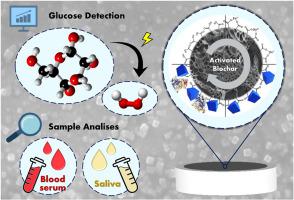Our official English website, www.x-mol.net, welcomes your feedback! (Note: you will need to create a separate account there.)
Nanostructures of Prussian blue supported on activated biochar for the development of a glucose biosensor
Talanta ( IF 6.1 ) Pub Date : 2024-04-03 , DOI: 10.1016/j.talanta.2024.126042 Cristiane Kalinke , Paulo R. de Oliveira , Luiz H. Marcolino-Júnior , Márcio F. Bergamini
Talanta ( IF 6.1 ) Pub Date : 2024-04-03 , DOI: 10.1016/j.talanta.2024.126042 Cristiane Kalinke , Paulo R. de Oliveira , Luiz H. Marcolino-Júnior , Márcio F. Bergamini

|
This work emphasizes the utilization of biochar, a renewable material, as an interesting platform for anchoring redox mediators and bioreceptors in the development of economic, environmentally friendly biosensors. In this context, Fe(III) ions were preconcentrated on highly functionalized activated biochar, allowing the stable synthesis of Prussian blue nanostructures with an average size of 58.3 nm. The determination of glucose was carried out by indirectly monitoring the hydrogen peroxide generated through the enzymatic reaction, followed by its subsequent redox reaction with reduced Prussian blue (also known as Prussian white) in a typical electrochemical-chemical mechanism. The EDC/NHS (1-ethyl-3-(3-dimethylaminopropyl)carbodiimide hydrochloride and N-Hydroxysuccinimide) pair was employed for the stable covalent immobilization of the enzyme on biochar. The biosensor demonstrated good enzyme-substrate affinity, as evidenced by the Michaelis-Menten apparent kinetic constant (4.16 mmol L), and analytical performance with a wide linear dynamic response range (0.05–5.0 mmol L), low limits of detection (0.94 μmol L) and quantification (3.13 μmol L). Additionally, reliable repeatability, reproducibility, stability, and selectivity were obtained for the detection of glucose in both real and spiked human saliva and blood serum samples.
中文翻译:

活性生物炭支持的普鲁士蓝纳米结构用于开发葡萄糖生物传感器
这项工作强调利用生物炭(一种可再生材料)作为锚定氧化还原介体和生物受体的有趣平台,以开发经济、环保的生物传感器。在这种情况下,Fe(III)离子被预富集在高功能化的活化生物炭上,从而可以稳定合成平均尺寸为58.3 nm的普鲁士蓝纳米结构。葡萄糖的测定是通过间接监测酶促反应产生的过氧化氢,然后以典型的电化学化学机制与还原的普鲁士蓝(也称为普鲁士白)进行氧化还原反应来进行的。 EDC/NHS(1-乙基-3-(3-二甲基氨基丙基)碳二亚胺盐酸盐和N-羟基琥珀酰亚胺)对用于将酶稳定地共价固定在生物炭上。该生物传感器表现出良好的酶-底物亲和力,米氏表观动力学常数 (4.16 mmol L-1) 以及具有宽线性动态响应范围 (0.05–5.0 mmol L-1) 和低检测限 (0.94 μmol L)和定量(3.13 μmol·L)。此外,在真实和加标的人类唾液和血清样品中的葡萄糖检测中,获得了可靠的重复性、再现性、稳定性和选择性。
更新日期:2024-04-03
中文翻译:

活性生物炭支持的普鲁士蓝纳米结构用于开发葡萄糖生物传感器
这项工作强调利用生物炭(一种可再生材料)作为锚定氧化还原介体和生物受体的有趣平台,以开发经济、环保的生物传感器。在这种情况下,Fe(III)离子被预富集在高功能化的活化生物炭上,从而可以稳定合成平均尺寸为58.3 nm的普鲁士蓝纳米结构。葡萄糖的测定是通过间接监测酶促反应产生的过氧化氢,然后以典型的电化学化学机制与还原的普鲁士蓝(也称为普鲁士白)进行氧化还原反应来进行的。 EDC/NHS(1-乙基-3-(3-二甲基氨基丙基)碳二亚胺盐酸盐和N-羟基琥珀酰亚胺)对用于将酶稳定地共价固定在生物炭上。该生物传感器表现出良好的酶-底物亲和力,米氏表观动力学常数 (4.16 mmol L-1) 以及具有宽线性动态响应范围 (0.05–5.0 mmol L-1) 和低检测限 (0.94 μmol L)和定量(3.13 μmol·L)。此外,在真实和加标的人类唾液和血清样品中的葡萄糖检测中,获得了可靠的重复性、再现性、稳定性和选择性。



























 京公网安备 11010802027423号
京公网安备 11010802027423号